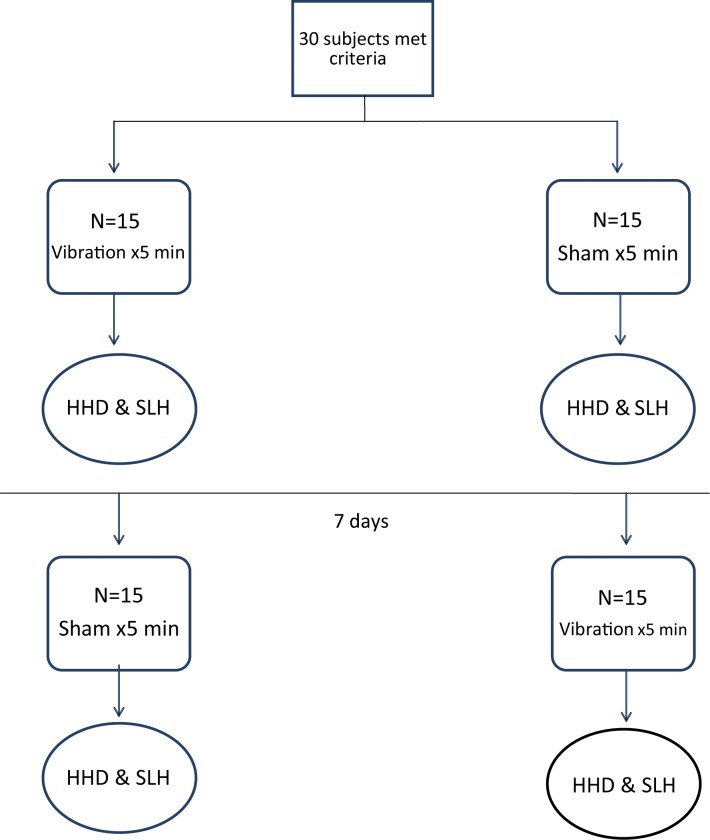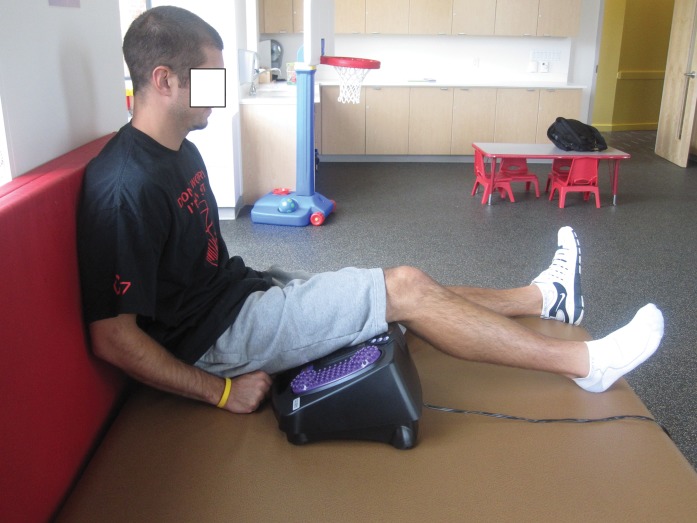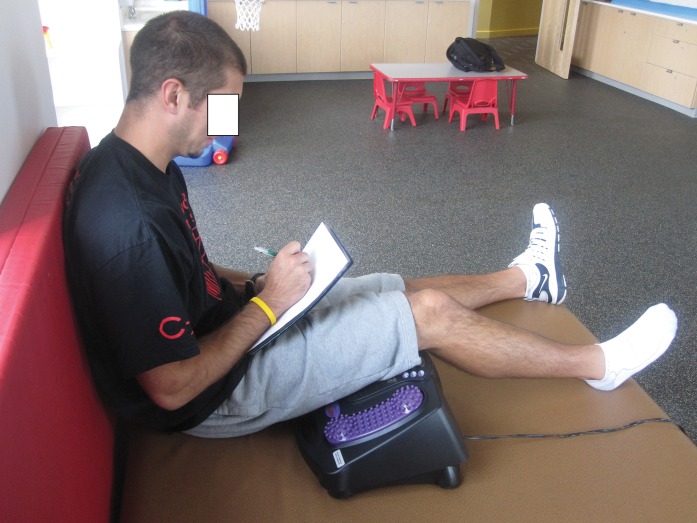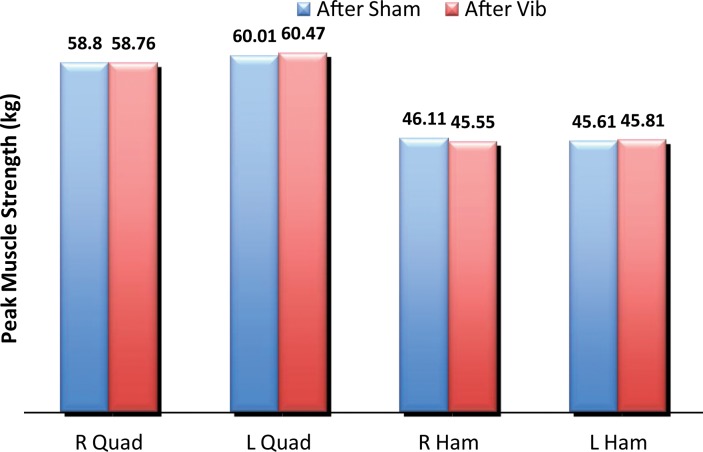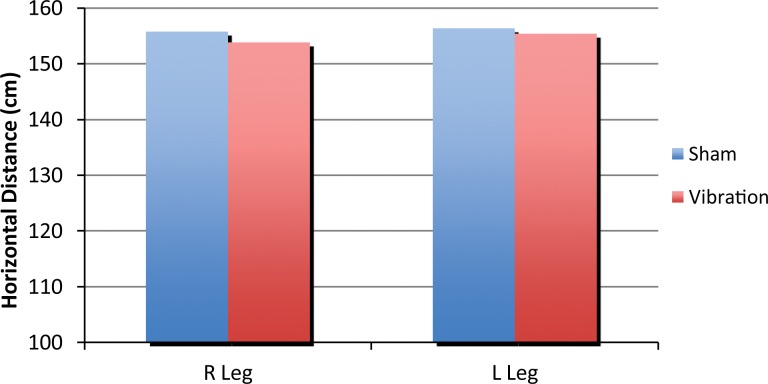Abstract
Purpose/Background:
A reduction in the maximal force output of muscles following pre-performance stretching has been reported. Several studies have suggested that localized vibration may enhance or replace stretching for gaining flexibility. It is important to know if localized vibration may also compromise muscle output. The purpose of this investigation was to determine the immediate effects of localized hamstring vibration on hamstrings (HAM) and quadriceps (QUAD) performance.
Methods:
Thirty asymptomatic participants, 19 female and 11 male, mean age 25.4 years (±SD 2.7) received either five minutes of localized vibration to the right hamstrings at 30 Hz and 6 mm amplitude, or sham. One week later, each participant received the alternate treatment. Following treatments, right (R) and left (L) isometric HAM and QUAD strength was measured twice by handheld dynamometer and maximal horizontal hop distance of each lower extremity was measured by single leg hop test (SLH). Treatment outcomes were compared using paired t-tests. Treatment order effect was measured by independent T-test. Pre-study intrarater reliability for dynamometry was established using ICC(3,2).
Results:
Mean (±SD) values for strength following vibration were 58.7 kg (15.7), 60.4 kg (14.0), 45.5 kg (14.2), 45.8 kg (13.2) for R QUAD, L QUAD, R HAM, L HAM respectively. SLH mean values were R SLH 153.8 cm (35 cm) and L SLH 155.4 cm (36 cm). There were no significant differences in means between vibration and sham treatment for any outcomes on either leg (p-values ranged .412-.971); p<.001 for all comparisons. Order had no significant effect (p-values .370–1.0). Intrarater ICCs were .888, .762, .884, .960 for R HAM, L HAM, R QUAD, L QUAD.
Conclusions:
Unilateral application of localized vibration to the hamstrings at a duration previously reported to increase flexibility did not diminish the isometric performance of the hamstrings or quadriceps of either leg.
Level of Evidence:
1b
Keywords: hamstring, muscle performance, vibration
INTRODUCTION
There are many athletic and performing arts settings in which participants are likely to benefit from having an increase in muscle extensibility while maintaining the ability to achieve maximal muscular force output.1 A reduction in either of these attributes may result in compromised performance. While stretching techniques have proven effective at increasing muscle extensibility, previous studies have reported that both static and dynamic stretching may cause a reduction in maximal force output that may last up to two days.2–4 Two theories exist as to why stretching causes a decrease in force production: a) there is an alteration in the resting length of the individual contractile fibers that results in detrimental conditions in the length-tension relationship, and b) there is a decrease in neuromuscular activation as a result of central nervous system inhibition.5 While the exact mechanism by which stretching adversely affects muscle strength is not fully understood, it may be that vibration has neurophysiological ramifications similar to stretching, including alteration of the viscoelastic properties of the musculotendinous unit.6,7
Sands et al, Kinser et al, and Issurin et al have shown that localized vibration enhances stretching as a way to increase muscle extensibility. Research using localized vibration at 30 Hz as part of a stretching warm-up demonstrated that gymnasts experienced a significant increase in range of motion in the hip joints.8–10 Durban et al found that localized vibration alone was equally effective as static stretching for enhancing hamstring passive mobility.11
While there is considerable evidence in the literature that whole body vibration enhances muscle performance,4,12–16 fewer studies have examined the effects of localized vibration on muscle performance.5,10,17 Localized vibration is a technique in which an external vibratory stimulus is applied to a specific muscle, muscle group, or joint. The results of the localized vibration research are contradictory. A decrease in peak torque of the ankle plantar flexors has been reported following both passive stretching and localized vibration to the Achilles tendon.5 Similarly, in a more recent study by Herda et al, a decrease in voluntary peak torque of the ankle plantar flexors was found following both prolonged passive stretching and localized vibration.17 Conversely, Issurin et al reported that localized vibration applied for short periods of time produced increased gains in maximal strength and flexibility of the hamstrings.10 The limited evidence and conflicting results of these studies indicate the need for further research to determine if localized vibration has an effect on peak muscle strength. Vibration studies to date have used various vibration parameters. Vibration frequencies between 20 Hz and 50 Hz have produced inhibitory effects upon the targeted muscle, while frequencies above 80 Hz have produced excitation.18 In studies attempting to evaluate vibration as a modality to increase muscle extensibility, the frequency has varied from 30 Hz to 44 Hz and the amplitude has varied from 2 mm to 3 mm.8–11
As far as tools for outcome measures, many options exist to measure hamstrings and quadriceps performance. Isokinetic dynamometry is considered to be the gold standard in assessment of peak muscle torque, but drawbacks of this method include the costly equipment requirements, the excessive amount of time required for setting up and running the dynamometer, and limited accessibility.18,19 Handheld dynamometry (HHD)18–20 and single-leg hop testing (SLH) are alternative lower extremity strength measurements that have been shown to be both reliable and valid, and are easy to administer and clinically available.21–25
In summary, discovering if localized vibration is a viable means to attain similar gains in muscle extensibility as static stretching while avoiding any deficits in peak muscle strength would be important for the performance of many athletes. Previous research has reported localized vibration to be an effective way of increasing muscle extensibility, but the evidence remains divided as to whether vibration results in a decrease in muscular force output. If localized vibration can increase muscle extensibility without causing deficits in muscular force output, it may replace static stretching as a means of increasing flexibility before athletic competition or performances. Therefore, the purpose of this study was to determine the immediate effects of localized 30 Hz vibration, applied to the right hamstrings, on quadriceps and hamstrings performance as measured via peak isometric muscle strength.
It is hypothesized that applying localized vibration to the right hamstrings will have no effect on peak muscle strength. This determination would contribute to one aspect of the ongoing discussion of localized vibration as an alternative to static stretching.
METHODS
A repeated measures cross-over design was used with independent variables of vibration treatment or sham treatment. The dependent variables were bilateral maximal isometric hamstrings and quadriceps contractions measured by HHD, and SLH for maximal horizontal distance of each lower extremity. A flow chart of participants is depicted in Figure 1.
Figure 1.
Flow chart of participants' progression through testing protocol.
Thirty asymptomatic university students (19 female, 11 male) between the ages 22–32 years (average age 25.4 years, SD 2.7) were recruited by word of mouth to participate in this study. Inclusion criterion was that subjects had to be able to move their knee against resistance through a full, normal range without pain. Participants were excluded if they reported any of the following; taking prescription blood thinners, known pregnancy, history of hamstrings or quadriceps injury within the last year, disc problems, sciatica, osteoporosis, knee instability, or bleeding disorders. None of the potential participants had to be excluded. Before participating, subjects were informed of possible risks and signed an informed consent form approved by the University of Puget Sound Institutional Review Board.
Prior to the onset of this study, 30 university students volunteered to participate in a pilot study to establish the intrarater reliability of the researcher performing the HHD measurements. Subjects of the pilot study were tested in the same position, and with the same timing, as the subjects in the study.
At initial visit, participants were randomly assigned to one of two treatments: 1) localized vibration, 2) sham technique. Random assignment was initiated by having the first participant draw a piece of paper from a hat. The paper had either “A” or “B” written on it, with “A” correlating to the localized vibration, and “B” correlating to the sham technique. After the first subject drew, the treatments were alternated for the remaining participants. Participants then received the assigned intervention and the outcome measures of right and left hamstrings and quadriceps peak strength, and SLH were assessed. At the second visit, one week later, subjects received the alternate treatment and outcome measures were tested again.
The vibration treatment consisted of five minutes of localized vibration applied directly to the right hamstrings using the Thumper Versa Pro Massager (Thumper Massager Inc. Markham, Ontario) set to 30 Hz with 6 mm of amplitude. Subjects were in a seated position with the hips flexed at 908 for the duration of the treatment (Figure 2). The sham treatment consisted of a mock neurological approach. For five minutes, subjects solved brain puzzles purchased at a grocery store newsstand that required processing of visual stimuli. Since this task predominantly involved the right cerebral hemisphere and the right hamstrings were being tested, direct neurologic influence on motor tasks would be minimized. Again, subjects were seated with the hips flexed at 908 for the duration of the sham treatment (Figure 3).
Figure 2.
Position of the subjects when receiving a five minute treatment of localized vibration to the right hamstring.
Figure 3.
Position of the subjects when receiving a five minute sham treatment of solving visual puzzles.
Immediately following each intervention, subjects proceeded to isometric testing of quadriceps and hamstrings peak strength, and then to a SLH for distance. Peak quadriceps strength was tested first followed by peak hamstrings strength for each subject. Testers of all outcome measures were blinded to which treatment subjects had received. To determine maximal isometric muscle strength, the tester secured a handheld MicroFET 2 dynamometer (Hoggan Health Industries, 8020 South 1300 West, West Jordan, UT 84088) against the distal, anterior tibia for quadriceps testing and against the Achilles tendon for hamstrings testing. For quadriceps testing, subjects were seated at the edge of a treatment plinth positioned so that both feet were off the ground, hips and knees both flexed at 90°. Subjects were instructed to fold their arms across their chest and maximally extend their knee against the tester's resistance. Hamstring testing was performed with the subjects in a prone position on a treatment plinth, hips in neutral extension and knees flexed to 90°. Subjects were instructed to maximally flex their knee against the tester's resistance. Subjects attempted two submaximal trials in each position for familiarization, followed by two recorded maximal contractions. The duration of each maximal effort was five seconds, with a 30-second rest in between trials, and a one-minute rest before testing the other side.
Subjects then performed SLH for maximal horizontal distance with measurement being taken from initial heel position to heel contact at landing. Each subject was allowed two practice jumps before the recorded jump. Subjects were instructed to “stick the landing” so that the foot did not move after initial contact and the untested foot did not touch the ground. After a one-minute rest, the opposite leg was tested. The mean of 2 dynamometry trials for each muscle group on each leg and the SLH distances of each leg were used in analysis.
STATISTICAL ANALYSIS
A two-way mixed intra-class correlation coefficient with average measures (ICC(3, 2)) was performed on pilot data to establish intrarater handheld dynamometer reliability. The data collected were normally distributed. A paired t-test was used to compare mean hamstrings and quadriceps forces and single-leg hop scores between vibration and sham applications. An independent T-test was used to compare means by treatment order. The alpha level for statistical significance was set, a priori, at 0.05. All data were analyzed using the Statistical Package for the Social Sciences (SPSS) version 19.
RESULTS
ICC(3,2)scores obtained from the pilot study demonstrated high intra-rater reliability. The scores for each measurement were .888, .762, .884, .960 for R HAM, L HAM, R QUAD, L QUAD respectively.
The mean and standard deviation values for maximal isometric quadriceps and hamstrings strength in kilograms for the right and left legs, following localized vibration and the sham treatment are listed in Table 1. Table 2 lists mean and standard deviation values for SLH for maximal horizontal distance in centimeters for the right and left legs following localized vibration and the sham treatment.
Table 1.
Mean ± standard deviation values for hamstring and quadricep strength bilaterally, following localized vibration and sham treatment, measured by handheld dynamometry in kg.
| R Quad after vibration | L Quad after vibration | R Ham after vibration | L Ham after vibration |
|---|---|---|---|
| 58.76 (±15.7) | 60.47 (±14.0) | 45.55 (±14.2) | 45.81 (±13.2) |
| R Quad after sham | L Quad after sham | R Ham after sham | L Ham after sham |
| 58.8 (±16.1) | 60.01 (±16.6) | 46.11 (±15.4) | 45.61 (±14.5) |
Table 2.
Mean ± standard deviation values for single leg hop test for maximal horizontal distance bilaterally, following localized vibration and sham treatment, measured in cm.
| R SLH after vibration | L SLH after vibration |
|---|---|
| 153.83 (±35.0) | 155.40 (±36.3) |
| R SLH after sham | LSLH after sham |
| 155.78 (±35.2) | 156.36 (±35.7) |
Paired t-tests demonstrated no statistically significant differences in means between vibration and sham treatment for any outcomes on either leg. The p-values for each comparison were .412, .666, .971, .730, .480, and .840 for R SLH, L SLH, R Quad, L Quad, R Ham, and L Ham respectively. Figures 4 and 5 illustrate the mean scores for maximal isometric contraction and SLH respectively under both conditions. Table 3 lists the results of the independent T-test, indicating that treatment order had no significant effect on mean scores for any measurement on either leg (p-values .152–1.0).
Figure 4.
Mean values for maximal isometric quadriceps and hamstring strength bilaterally, following sham treatment and localized vibration, using handheld dynamometry.
Figure 5.
Mean values for single-leg hop test for maximal horizontal distance bilaterally, following localized vibration and sham treatment.
Table 3.
Independent T-test p-values showing that treatment order had no significant effect onmean scores for any measurement on either leg.
| R SLH after vibration | L SLH after vibration | R Quad after vibration | L Quad after vibration | R Ham after vibration | L Ham after vibration |
|---|---|---|---|---|---|
| .780 | .370 | .988 | .681 | .927 | .841 |
| R SLH after sham | L SLH after sham | R Quad after sham | L Quad after sham | R Ham after sham | L Ham after sham |
| .799 | .831 | .539 | .152 | .852 | 1.00 |
DISCUSSION
The results of this study suggest that the application of localized vibration to the right hamstrings will not result in a change in muscle performance of the hamstrings or quadriceps of either leg as noted during an isometric assessment and functional testing. The five-minute length of localized vibration treatment was selected as this length of exposure was equally as effective as static stretching for enhancing hamstring passive mobility when utilized by Durban et al.11 Subjects of this study were tested for bilateral hamstrings and quadriceps strength and performance although localized vibration was only applied to the right hamstrings. Previous research has shown that unilateral application of localized vibration resulted in passive range of motion gains bilaterally.11 Testing of bilateral strength and performance was conducted to ensure that there were no deficits that carried over in the same manner as the passive range of motion gains. No changes in muscular strength occurred related to application of vibration, as measured isometrically or via a functional test.
Previous research has been conducted to investigate test-retest reliability, minimal clinically important difference, of isometric knee flexion and extension.18 It was determined that the smallest real difference was 28.2% and 21.5% for isometric knee flexion and extension respectively. The paired T-tests used to compare the mean values for isometric knee flexion and extension in the present study yielded p-values ranging from .412-.971. Thus, there was not a change in the peak isometric force the flexion and extension contractions great enough to indicate a genuine clinical change.
The findings of this study are useful in conjunction with previous research that has found that 5 minutes of localized vibration alone was equally as effective as static stretching for enhancing hamstring passive mobility.11 Both static and dynamic stretching have been shown to cause a decrease in maximal force output, and this reduction can last up to two days.2–4 Therefore, applying localized vibration to the hamstrings prior to athletic competition may be a viable alternative to stretching as a means to increase muscle extensibility without risking strength deficits. Physical therapists are often in a position to advise and educate patients on safety and methods of maximizing performance for athletic competition or general exercise. The findings of this study will allow physical therapists to provide patients with accurate information on the concurrent effect of localized vibration on isometric strength and muscle performance during the single limb hop.
A muscular strength imbalance between the hamstrings and quadriceps is an intrinsic risk factor for hamstring strains.26–28 Many athletes perform pre-activity stretching with the belief that increasing the flexibility of the hamstrings will reduce their risk of incurring a hamstring strain. However, they may, in fact, be placing themselves at an increased risk, as stretching may reduce hamstrings strength, thus increasing the muscular imbalance between the hamstrings and quadriceps.2–4 The results of the current study suggest that, if used for increasing muscle extensibility, localized vibration will not place athletes at an increased risk of hamstring strains due to any deleterious effect on hamstring strength.
There were several limitations present in this study. Researchers used handheld dynamometry and single-leg hop tests as strength measurements instead of the gold standard of isokinetic dynamometry. Although handheld dynamometry and single-leg hop tests have been shown to be both valid and reliable, they do not test the maximal force output throughout the entire range of motion as isokinetic dynamometry does.18–25 Handheld dynamometry only measures maximal force output at one standardized joint angle, and a single leg hop test has other factors involved, including balance, technique, and the many other segments in the kinetic chain. This study used a sample size of 30 participants. Future research with a larger sample size and with the use of isokinetic dynamometry to measure muscle strength would add credibility and strength to the results found in this study. Although the vibration frequency used in this study was the same as previous studies that have shown localized vibration to improve hamstrings extensibility,11 muscle extensibility was not measured in this study. Perhaps the disagreement between the current study and those reporting a loss of strength following localized vibration may be related to amplitude. An amplitude of 6 mm was used in the current study, in contrast to 2–3 mm amplitude that was used in other studies. The optimum amplitude, intensity, and duration parameters for localized vibration to achieve successful outcomes for length and strength have yet to be determined.
CONCLUSION
Localized vibration applied to the hamstrings of one lower extremity did not impair isometric or functional muscle output of the quadriceps or hamstrings bilaterally. When combined with findings from previous studies involving vibration and muscle extensibility, the current findings support the use of localized vibration as an alternative to static stretch. Further research is needed with larger sample sizes, isokinetic dynamometry, and development of vibration parameters for a protocol to be utilized with athletes.
REFERENCES
- 1.McNeal JR, Sands WA. Stretching for performance enhancement. Curr Sports Med Rep. 2006; 5:141–146 [DOI] [PubMed] [Google Scholar]
- 2.Bacurau RFP, Monteiro GA, Ugrinowitsch C, et al. Acute effect of a ballistic and static stretching exercise bout on flexibility and maximal strength. J Stren Cond Res. 2009; 23:304–308 [DOI] [PubMed] [Google Scholar]
- 3.Winchester JB, Nelson AG, Kokkonen J. A single 30-s stretch is sufficient to inhibit maximal voluntary strength. Res Quart Exerc and Sport. 2009; 80:257–261 [DOI] [PubMed] [Google Scholar]
- 4.Nelson AG, Kokkonen J, Eldredge C. Strength inhibition following an acute stretch is not limited to novice stretchers. Res Quart Exerc and Sport. 2005; 76:500–506 [DOI] [PubMed] [Google Scholar]
- 5.Herda TJ, Ryan ED, Smith AE, et al. Acute effects of passive stretching vs vibration on the neuromuscular function of the plantar flexors. Scand J Med Sci Sports. 2009; 19:703–713 [DOI] [PubMed] [Google Scholar]
- 6.Halbertsma J, Von Bolhuis A, Goeken L. Sport stretching: effect on passive muscle stiffness of short hamstrings. Arch Phys Med and Rehab. 1996; 77:688–692 [DOI] [PubMed] [Google Scholar]
- 7.Magnusson S, Simonsen, Dyhre-Poulsen P, et al. Mechanical and physiological responses to stretching with and without preisometric contraction in human skeletal muscle. Arch Phys Med and Rehab. 1996; 77:373–378 [DOI] [PubMed] [Google Scholar]
- 8.Sands WA, McNeal JR, Stone MH, et al. Flexibility enhancement with vibration: acute and long-term. Med Sci Sports Exerc. 2006; 38:720–725 [DOI] [PubMed] [Google Scholar]
- 9.Kinser AM, Ramsey MW, O'Bryant HS, et al. Vibration and stretching effects on flexibility and explosive strength in young gymnasts. Med Sci Sports Exerc. 2007; 40:133–140 [DOI] [PubMed] [Google Scholar]
- 10.Issurin VB, Liebermann DG, Tenenbaum G. Effects of vibratory stimulation on maximal force and flexibility. J. Sports Sci. 1994; 12:561–566 [DOI] [PubMed] [Google Scholar]
- 11.Durban E, Matlock S, Piers-VanderPloeg S, et al. A comparison of the immediate effects of localized vibration versus static stretch on hamstring flexibility. Presented at The Twenty-Eighth Annual Symposium Medical Problems of Performing Artists, July 30, 2010, Snowmass, Co.
- 12.Hazell TJ, Jakobi JM, Keno KA. The effects of whole-body vibration on upper- and lower-body EMG during static and dynamic contractions. Appl Physiol Nutr Metab. 2007; 32:1156–1163 [DOI] [PubMed] [Google Scholar]
- 13.Homma S. A survey of Japanese research on muscle vibration. New Developments in Electromyography and Clinical Neurophysiology. 1973; 3 [Google Scholar]
- 14.Roelants M, Delecluse C, Verschueren SM. Whole-body-vibration training increases knee-extension strength and speed of movement in older women. J Am Geriatr Soc. 2004; 52:901–908 [DOI] [PubMed] [Google Scholar]
- 15.Schyns F, Paul L, Finlay K, et al. Vibration therapy in multiple sclerosis: a pilot study exploring its effects on tone, muscle force, sensation and functional performance. Clin Rehabil. 2009; Epub ahead of print. [DOI] [PubMed] [Google Scholar]
- 16.Tihanyi TK, Horvath M, Fazekas G, et al. One session of whole body vibration increases voluntary muscle strength transiently in patients with stroke. Clin Rehabil. 2007; 21:782–793 [DOI] [PubMed] [Google Scholar]
- 17.Herda TJ, Ryan ED, Costa PB, et al. Acute effects of passive stretching and vibration on the electromechanical delay and musculotendinous stiffness of the plantar flexors. Electromyogr Clin Neurophysiol. 2010;50:277–88 [PubMed] [Google Scholar]
- 18.Adsuar JC, Olivares PR, del Pozo-Cruz B, et al. Test-retest reliability of isometric and isokinetic knee extension and flexion in patients with fibromyalgia: evaluation of the smallest real difference. Arch Phys Med Rehabil.2011;92(10):1646–51 [DOI] [PubMed] [Google Scholar]
- 19.Stark T, Walker B, Phillips JK, et al. Hand-held dynamometry correlation with the gold standard isokinetic dynamometry: a systematic review. PM R. 2011;3(5):472–9 [DOI] [PubMed] [Google Scholar]
- 20.Arnold C, Warkentin K, Chilibeck P, et al. The reliability and validity of handheld dynamometry for the measurement of lower-extremity muscle strength in older adults. J Strength Cond Res. 2010;24:815–824 [DOI] [PubMed] [Google Scholar]
- 21.Bolgla LA, Keskula DR. Reliability of lower extremity functional performance tests. J Orthop Sports Phys Ther. 1997;226:138–142 [DOI] [PubMed] [Google Scholar]
- 22.Daniel KM, Stone ML, Riehl B, et al. A measurement of lower limb function: the one leg hop for distance. Am J Knee Surg. 1982;1:212–214 [Google Scholar]
- 23.Kawaguchi J, Babcock G. Validity and reliability of handheld dynametric strength assessment of hip extensor and abductor muscles. Athl Training & Sports Health Care. 2010;2:11–17 [Google Scholar]
- 24.Kramer JF, Nusca D, Fowler P, et al. Test-retest reliability of the one-leg hop test following ACL reconstruction. Clin J Sport Med. 1992;2:240–243 [Google Scholar]
- 25.Paterno MV, Greenberger HB. The test-retest reliability of a one legged hop for distance in young adults with and without ACL reconstruction. Isokinet Exerc Sci. 1996;5:1–6 [Google Scholar]
- 26.Fousekis K, Tsepis E, Poulmedis P, et al. Intrinsic risk factors of non-contact quadriceps and hamstring strains in soccer: a prospective study of 100 professional players. Br J Sports Med. 2011;45(9):709–14 [DOI] [PubMed] [Google Scholar]
- 27.Emery C. Does decreased muscle strength cause acute muscle strain injury in sport? A systematic review of the evidence. Phys Ther Rev. 1999;4(3):141–51 [Google Scholar]
- 28.Newsham K. Sportsmed omnibus. The role of neural tension in hamstring injury, part 2: treatment and rehabilitation. Athletic Ther Today. 2006;11(5):66–9 [Google Scholar]



